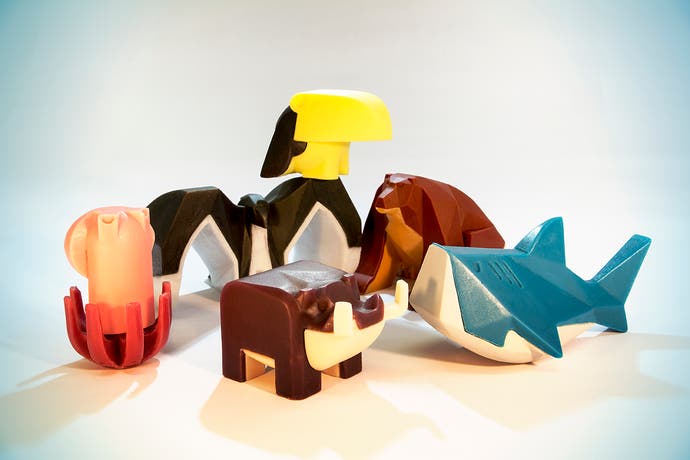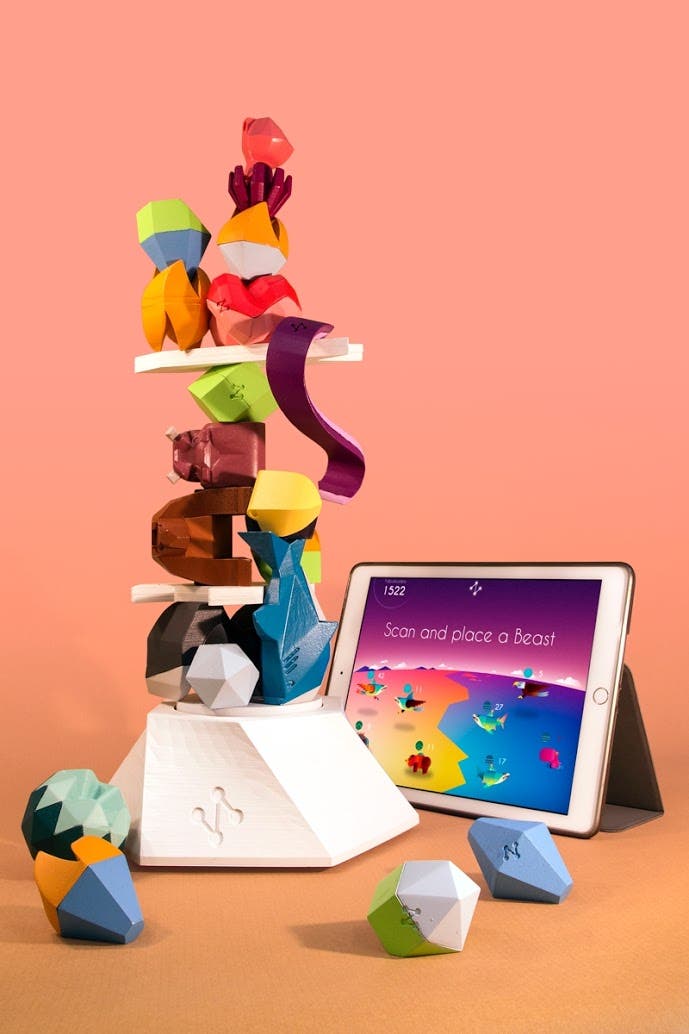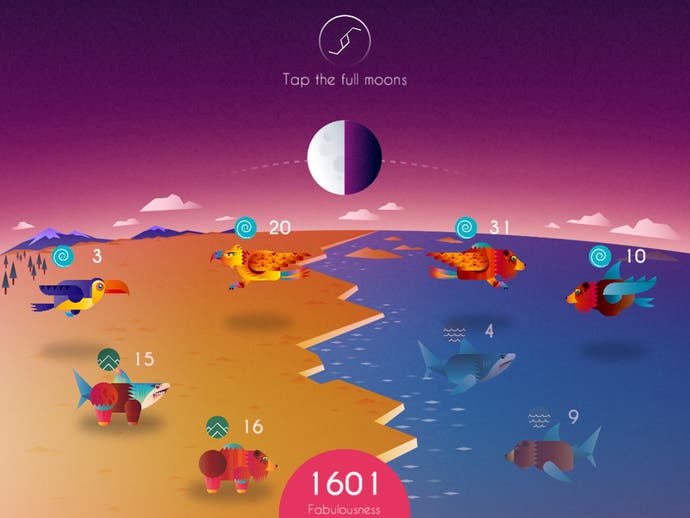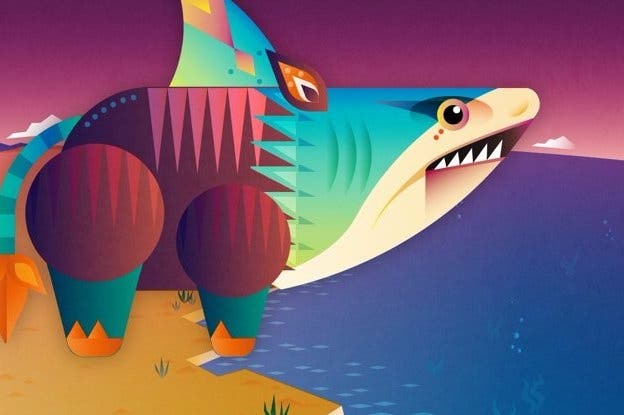Fabulous Beasts is Jenga for the gods
Make the bear kiss the eagle.
The octopus is my favourite. Angular yet organic, stylised and yet immediately recognisable, with those stern, strangely ancient eyes that octopuses - octopode? - tend to have. She is warm to touch, with tacky paint and a gentle grain beneath it. You would think this was wood, if it were not for the lack of heft. The octopus is made of plastic, and fresh - relatively fresh - out of a 3D printer.
I'd never seen something emerge from a 3D printer before. It turns out that they come out with these artefacts all over them, delicate little twills and imperfections that need to removed with gentle knifework. They also come out with supporting struts and sprues that the computer has added automatically so that the whole thing doesn't crumple during the many hours of construction, of one layer being laid upon the last.
And there are limits to what you can actually print in the first place. What's the least printable animal? I ask. Wrong crowd. Least printable is not on the radar, it turns out. What's the most collectable? someone else wonders. What's the most stackable? These are the vital questions. Startups are about the mosts, not the leasts. Very 10X. Discussion ensues.
For the time being, the octopus, along with a toucan, a shark, and a handful of other animals, lives somewhere in the basement of Somerset House on the north bank of the Thames. You have to go through a funny little side door to get here, and then down what feels like three flights of tightly looped stairs but is probably only two. People start to talk about sub-basements. "It begins to feel a bit City 17, doesn't it?" says Alex Fleetwood, the founder and CEO of Sensible Object, who's showing me the way. We pass an ancient fire hose coated in dust. We pass leaded windows.

Down here is the Makerversity, a fascinating congregation of new businesses forming an accidental street that has emerged between two large buildings. It's a street that seems hidden away, trapped within Somerset House itself, and it inevitably feels a little like Diagon Alley from Harry Potter. Fleetwood runs one of the businesses, although when I ask a colleague of his later on, there's some confusion over whether they're part of Makerversity or just share a kitchen.
They certainly share an ethos: the Maker movement is all about knocking new stuff together in unexpected ways, about "getting your hands dirty", about applying your own artist's scalpel to your own 3D printing. There's a bio-hacking company down here that has an office with elegant Victorian armchairs in it and nothing, to my eyes at least, that looks much like a biology lab (as if I would know). Fleetwood, rather fittingly, runs a games company that operates within a space that resembles a posh CDT classroom. He runs a games company that is also a hardware company. The game and the hardware are one.
The game is called Fabulous Beasts. If you absolutely demanded it, I'd tell you it's a blend of Jenga, Skylanders and Hearthstone, but that doesn't really get you very close to the truth. And anyway, I'd rather tell you this: here is how it begins.
"We are gods," says Fleetwood. Always nice to hear. "We are a family of gods who are creating a new world. And that world, we hope, will be full of fabulous beasts."

Between Fleetwood and I on the table we're sat at is a small plinth, painted white - or maybe printed white - and made, I think, of the same grainy, textured plastic as the octopus. The octopus is with us as well, along with a few friends and some other bits and pieces of a similar size and aesthetic.
Fleetwood picks up a small plastic bear. "The way that we fill the world is by taking these magical artefacts and using them to build a balancing tower. If the tower you're building falls over, the world you are creating comes to an end."
It's my turn to go first. I choose the octopus. I hold her against the base for a second until she's registered, and then I place her on the plinth. An iPad pings to life, depicting a colourful primeval world divided into three ecologies: sea, earth and air. My octopus appears in the sea.
"The octopus is reasonably fabulous," explains Fleetwood, pointing to a number that's appeared next to it on the iPad. "It has three points of fabulousness at the start of the game." He explains that co-operative gods like us want the fabulousness score to grow as we play. It is the sum total of all the fabulousness of all the beasts we place on the plinth.
Fleetwood's turn. He scans in a warthog, and places him on the plinth opposite the octopus. He's also reasonably fabulous, and our score starts to build. Being a god is quite rewarding!
The warthog's also roughly the same height as the octopus, and in a game about building a tower, that's a good sign. It's my turn again, and before I reach for the toucan, Fleetwood explains that I have other options. Alongside beast pieces, I can place action pieces, which tend to be flat, allowing you to create makeshift shelves and platforms as you build. Action pieces come in two forms: cross and migrate. Cross pieces allow you to blend beasts to make new fabulous hybrids. Migrate pieces allow you to make a copy of a beast and move it from one ecology to another: again, fabulousness ensues.
I choose a cross piece - everybody does at first - and as I balance it on the tower, I'm delighted to see a hogtopus spring to life. It's fabulous, boasting a score that is the sum of both its ancestors combined. But here's where things start to get complicated and, to be honest, rather typical, if you've read much about gods and their general problems. Jealousy has been born alongside the hogtopus. The hogtopus is so fabulous that the octopus and the warthog are feeling a bit annoyed about it all, and their fabulousness is starting to wane as a result.
We play on, and for all its complexity, it's beautifully coherent: each piece you add complicates the ecosystem of fabulousness on the iPad, affecting your score, while also adding to the tower you're building on the plinth, creating new possibilities and new instabilities. Alongside animals and action pieces, you can place element pieces that boost the fabulousness of different ecologies, and then there are miracles. Miracles temporarily make everything in the world twice as fabulous, but they're difficult shapes to build with - one is rounded, one is knotty, one is a single wriggle of ribbon - and when you place them they impose taxes in the form of real-world challenges. A miracle of weight requires you to push down on the tower when you add a piece, for example, while a miracle of distraction gives you something purposefully annoying to do on the iPad screen, dividing your attention while you mess with the tower.

This, I think, gets at the heart of what makes Fabulous Beasts so alluringly coherent: a piece that is powerful in the digital world must be balanced by a tricky shape in the physical world. The digital and the physical are linked, not in a dance of dull equivalence, but in a knotty, complicated way that opens up strategies, opportunities, and the potential for disasters. Fabulous Beasts is interested in gods of the Ancient Greek inclination: boozy superheroes who totter from one self-inflicted drama to the next.
Just as the octopus and the warthog came together to create an alluring hybrid, in other words, Fleetwood and his team has managed to truly combine physical and digital elements. Hardware and software. And this was always part of the plan. Fleetwood even has a cool phrase for it: "crossing the streams". Never do that. Right?
"What we're trying to be is an indie hardware games company," he explains. "We've had indies for, what ten years? Arguably longer, but that first big wave feels like about ten years." To his eyes, Fabulous Beasts is a natural evolution of that - as natural as an octopus that walks on land, at any rate, or a warthog that heads for the sea.
"Part of what allowed indies to happen were tools," he continues. "Tools like Flash that meant you could experiment with ideas more readily, publishing tools like the App Store and Steam. What we are doing is using a set of tools that means you can now do the physical stuff of prototyping as well as the software stuff. The technology that's inside the game, there's a couple of sensors that are tracking the pieces you play, there's code that allows us to interpret that in real time, and then there's a bluetooth module that connects to the iPad. You can't exactly walk into Maplins and buy that, but you almost can. It's that level of availability."
Fabulous Beasts is an idea that Fleetwood's been pursuing for a while. Before Sensible Object he was the boss of Hide&Seek, another studio interested in the intersection of games with other things - things like films, museums, physical social games and public spaces. "What started to happen, and the thing I was most interested in, was that there was this new interstitial layer that meant you could connect the two parts of game history," he says. "The 50 years of video games, which were being miniaturised and made more mobile and being more and more a part of our daily lives, and on the other hand you have tabletop games or card games or parlour games, that sort of situated social activity. Sensors and hardware, and the ease with which you can connect puzzle pieces to something like an iPad, means that you can maybe start to experiment with putting these things together in new ways."

After Hide&Seek closed its doors in 2013, Fleetwood raised a bit of R&D and partnered with the mechanical engineering department at Bath University. He had four months to work on a prototype and pull a team together, and he had a sketch of an idea that was based on an old Hide&Seek project, in which you matched the different faces of blocks. That was an idea that stuck because it had felt more like excavation than creation the first time around: the game felt like it was there and waiting all along. "I always thought it would be nice to do a version of that which digitally tracked the whole thing," Fleetwood laughs. "The thing in my head was a physical stacking game with a digital component."
But how to do it? "The first version was a block-stacking game with a camera pointed at it, and the idea that you would computer-vision-track the tower," Fleetwood explains. "We talked about computer vision, and how impossibly hard it is, and then we had this R&D process where Chris Shaw, our engineer, went through all the different ways you can sense non-powered blocks. After all of that process we came up with a weight sensor. In the tower is a weight sensor. Whenever you add a piece to the game, you scan it in, and then it's waiting for the weight of that piece to be added to the tower."
That was version one. Then came a trip to GDC and the word of mouth began. The team raised a little more money and started in on version two.
Fleetwood shows me a few of the pieces from the first version. The beasts are angular and often spiky, and the couple I see are painted gold. They look like difficult art; there's a slight Futurist vibe to them. You wouldn't want to sit on them, anyway - not that sitting on the current toucan model would be a picnic.
In keeping with the sharper edges, the first version of the Fabulous Beasts was player-versus-player. "It was quite hard, a strategic battling game," says Fleetwood. "You were cooperating to build a tower but you were also trying to nurture your own set of fabulous beasts. Your first game is always too complicated and always too hard. The thing about a game like this is that we're already asking players to take on a lot of new information, so that already sets the bar fairly high for learning new stuff."
I ask if the success of Skylanders and its ilk makes things easier. "There's certainly a few things happening these days that indicate the direction of travel we're in," he muses. "You've also got tabletop games with a digital element - XCOM, the board game version, for example. We're learning a new language. It's a question of what do you want the computer to do? What do you want to delegate to the computer? You don't necessarily want to give up all the simulation in a board game. Learning a system and immersing yourself into it is part of the fun."

Fleetwood describes the current state of play as "alpha". There's now a Kickstarter, and, when we meet in December, he feels the game is around a year away from shipping. Or should that be launching? Is this a living game?
"Assuming all goes well, we really hope so," he says. "I think the inspiration of things like Magic, where you can continually refresh it, holds true. What's exciting about having a physical/digital hybrid game is that the refresh potential is multiplied. We can ship a new game mode, or ship new pieces, or we can even ship different sets of pieces with new form factors. Ultimately, we could even ship new hardware and new kinds of sensors."
I think Fleetwood's onto something. Not just because his game is coherent and clever and feels rather timely, but because, as we chat, I can't stop playing with the pieces, turning them over in my hands, discovering new ways of standing them up. Even now, prior to the injection-molded mass production stage, they feel nice to hold: a good size in the fist. I can imagine shaking them out of the box and onto the carpet. I can imagine clogging the vacuum with them. I can imagine stepping on the shark as I go for a glass of water in the middle of the night.
The shark! The more we play, the more unstable the tower becomes. Where to put the shark? A long, curving body, a tale and snout that both suggest showboating possibilities. How to balance her?
Things are already falling apart. The beasts on the iPad suffer shockwaves of low self-esteem that pass from one creature to the next, decimating their cumulative fabulousness. The interactions are fascinating to untangle. The miracles we've placed are starting to stack, too, so each move has a tax measured in distraction, in fumbling. Even before game one is over, I'm thinking about game two and what I'll do differently. I'm starting to understand why gods might fancy the flood option.
"Do you find the same shapes emerging again and again?" I ask after the whole thing has finally toppled. God Score: 550. (Not bad?)
"Really surprisingly, never," says Fleetwood. "One of the understandable assumptions that tabletop people make is that there's a solution - there's an optimal way. The pieces are quite deliberately chaotic in their design. There aren't many things that have the same height, and then they can be played in a number of different orientations.
"That said, logical strategies started to emerge. Lots of people begin their second game with eagle/bear. They make the eagle and bear kiss because it gives you a lovely platform to build upon. But then what's interesting is that then a miracle goes on, and it tends to drive a line through someone's careful strategy. Games are made in dialogue. You know?" He pauses and thinks. "What does high-level play for a game like this actually look like?"
Alex Wiltshire, a member of the Sensible Object team, is a former Eurogamer contributor and friend of the site.









